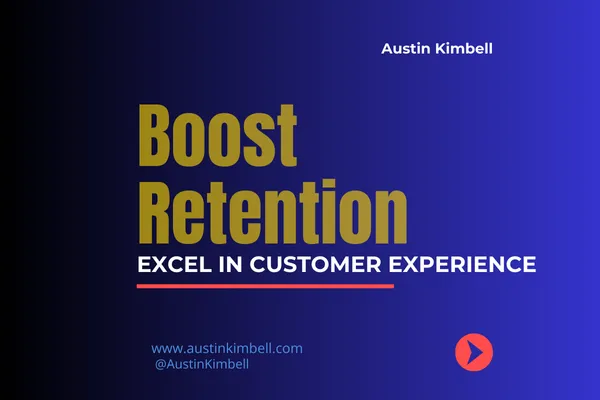
How Exceptional Service Can Boost Customer Retention
Introduction
In today's competitive market, exceptional customer service is not just a differentiator—it's essential. With numerous brands vying for attention, businesses that prioritize customer experience not only attract but also retain loyal customers, creating a foundation for long-term growth. According to a study by PwC, 59% of customers will abandon a brand after a single poor experience, while 86% are willing to pay more for a great customer experience. This makes exceptional service one of the most reliable strategies for driving customer retention.
This blog explores how outstanding service enhances customer loyalty, offers real-life examples from companies known for their customer-centric approach, and provides actionable steps for implementing automation without compromising the personal touch that customers expect.
The Impact of Exceptional Service on Customer Retention
Exceptional customer service is a powerful tool for building loyalty and encouraging repeat business. Research shows that prioritizing customer experience can increase sales revenue by 2-7% and improve profitability by 1-2% (HubSpot Blog). These figures illustrate that customer service goes beyond a "nice-to-have" and significantly impacts the bottom line.
Here’s why customer service is critical for retention:
First Impressions Matter: A poor experience can drive customers away. Conversely, a positive interaction leaves a lasting impression, making customers more likely to return.
Creates Emotional Connections: Exceptional service fosters trust and emotional bonds with the brand, creating customers who are not only loyal but also become advocates.
Encourages Higher Spending: Customers who feel valued and understood are more likely to make repeat purchases, upgrade their services, and explore other offerings.
Reduces Churn: Effective customer service addresses customer issues promptly, reducing dissatisfaction and lowering churn rates. Churn rate reduction is a significant factor in profitability, especially in subscription-based businesses.
Case Studies: Companies Excelling in Customer Service
Some brands have set the gold standard for customer service, leading to impressive loyalty rates and customer satisfaction scores. Below are two standout examples.
Zappos: Setting the Bar for Customer-Centric Service
Zappos is renowned for its commitment to customer service. From free shipping to a 365-day return policy, Zappos prioritizes convenience for its customers. The company’s dedication extends beyond policies—Zappos encourages employees to create memorable experiences through personal interactions and goes the extra mile to satisfy customers.
Results: Zappos boasts a 75% repeat customer rate, demonstrating that customers return to brands that make them feel valued.
Why It Works: Zappos places customer satisfaction above all else, and its flexible policies provide an added sense of security and trust.
Ritz-Carlton: Luxury Service That Puts Customers First
The Ritz-Carlton brand has built a reputation for personalized service. The luxury hotel chain empowers employees with the freedom to spend up to $2,000 per guest to resolve issues and enhance experiences. This policy ensures guests receive tailored service, creating positive, lasting impressions that keep customers coming back.
Results: High repeat business and loyalty rates, as well as exceptional customer satisfaction scores.
Why It Works: By empowering employees to make real-time decisions, Ritz-Carlton creates unique and memorable customer experiences that resonate with guests.

Integrating Automation Without Losing the Personal Touch
Automation is invaluable for streamlining customer service processes, especially for handling routine tasks. However, automation must be used thoughtfully to avoid compromising the personal connection that builds loyalty. Here’s a structured approach to balancing efficiency with personalization.
Automation in Customer Service Checklist
Identify Areas for Automation
Determine which tasks can be automated without compromising quality. Examples include order confirmations, shipping notifications, and basic inquiries via chatbots.
Choose the Right Automation Tools
Opt for tools that match your business needs and customer expectations. AI-powered chatbots can manage straightforward queries, freeing human agents to handle more complex issues.
Implement Automation Without Compromising Personalization
Ensure automated interactions feel personalized by using customer data to tailor responses. For instance, address customers by their name, and reference their order history or preferences where possible.
Monitor Customer Feedback on Automated Services
Regularly collect feedback to assess the effectiveness of your automated services. This helps you identify which areas customers appreciate and which need further refinement.
Continuously Refine and Improve Automated Processes
Use customer feedback and performance metrics to make ongoing adjustments. Automation should enhance the customer experience, not detract from it.
Balancing Automation and Human Interaction
While automation can handle routine queries, complex issues often require the empathy and understanding that only a human can provide. According to a Zendesk study, 70% of consumers feel more favorably about brands that seek and act on customer feedback. Balancing automated and human touchpoints is essential for maintaining satisfaction.
Strategies to balance automation and human interaction include:
Hybrid Service Models: Use automation to address basic questions and route complex issues to human agents.
Human Escalation Options: Ensure that customers have an easy way to connect with a human if they’re not satisfied with automated responses.
Personalized Chatbot Responses: Customize automated responses using customer data for a more personalized approach, such as recommending products based on previous purchases.
Key Benefits of Exceptional Service for Customer Retention
The benefits of delivering exceptional customer service extend beyond customer satisfaction. Below are some of the primary advantages:
1. Builds Brand Trust and Reputation
When customers feel valued and respected, they’re more likely to trust the brand. Exceptional service builds a solid reputation, leading to organic growth through referrals.
2. Encourages Higher Customer Lifetime Value (CLV)
Satisfied customers are likely to spend more over time, directly impacting CLV. High CLV indicates a strong customer-brand relationship and is a valuable asset for business growth.
3. Enhances Customer Loyalty and Advocacy
Happy customers become brand advocates, sharing their positive experiences with others. This advocacy reduces the cost of acquiring new customers and promotes organic growth.
4. Reduces Negative Reviews and Public Complaints
Excellent customer service can prevent issues from escalating, reducing negative reviews that can deter potential customers. Customers who feel heard are less likely to voice dissatisfaction publicly.
Leveraging Customer Feedback for Service Improvement
Customer feedback is a goldmine of insights that can drive continuous service improvement. Actively seeking feedback allows businesses to identify pain points and adjust processes accordingly. Here’s a step-by-step approach to using feedback effectively:
Solicit Feedback Across Multiple Channels: Use surveys, follow-up emails, and review platforms to gather customer opinions. These insights provide a comprehensive view of the customer experience.
Analyze and Identify Patterns: Regularly review feedback to detect recurring themes and areas needing improvement. Tools like C4 Payments can automate the feedback collection and analysis process, providing real-time insights.
Implement Changes Based on Feedback: Address pain points by updating policies, improving service workflows, or refining customer touchpoints.
Communicate Changes to Customers: Keep customers informed of improvements, showing them that their feedback matters. For instance, Spotify frequently updates users on new features inspired by customer requests, reinforcing brand loyalty.
Case Study: The Power of Proactive Service at JetBlue
JetBlue demonstrates the impact of proactive customer service. In response to customer feedback, JetBlue introduced complimentary in-flight WiFi, setting it apart from competitors. This amenity was a direct result of listening to customer requests, showcasing the airline’s commitment to enhancing the passenger experience.
Result: JetBlue’s proactive approach has increased customer loyalty and made the brand synonymous with high-value service.
Lesson Learned: Proactively acting on feedback creates loyalty, as customers feel valued and recognized.
Conclusion
Exceptional customer service is the cornerstone of customer retention and business growth. When businesses prioritize service quality, they foster customer loyalty, encourage repeat business, and create brand advocates. However, balancing automation with human interaction is crucial to maintain a personal touch that resonates with customers. Using a thoughtful approach to automation—alongside tools like C4 Payments to gather feedback and improve processes—enables businesses to enhance efficiency without compromising the customer experience.
Automation in Customer Service Recap:
Identify tasks that can be automated without sacrificing quality.
Use customer data to personalize automated responses.
Monitor feedback on automated interactions to ensure effectiveness.
Continuously refine automation processes to improve customer satisfaction.
By maintaining high standards for service and integrating automation strategically, businesses can create a customer-centric experience that fosters loyalty, drives growth, and sets them apart in today’s competitive marketplace.
Ready to elevate your customer service strategy? Contact us at AustinKimbell.com to learn how a balanced approach to automation and personalized service can enhance customer loyalty and retention. Let’s build a retention strategy that drives lasting success!
